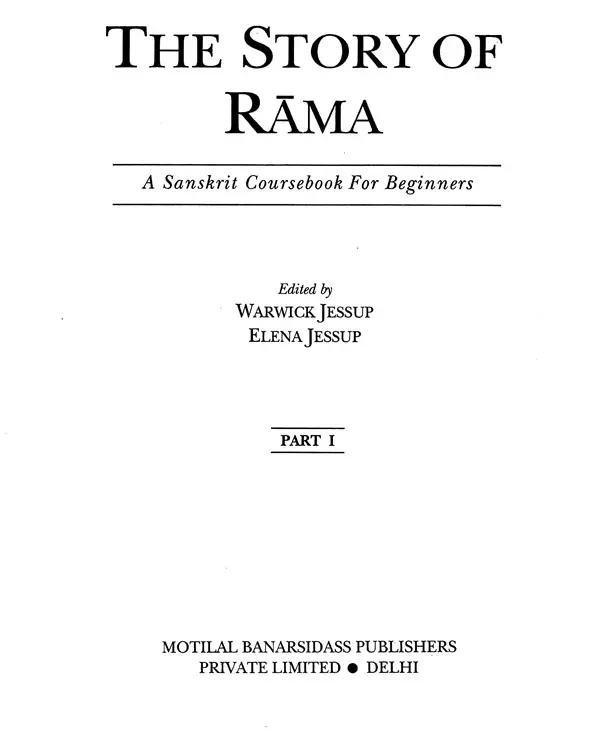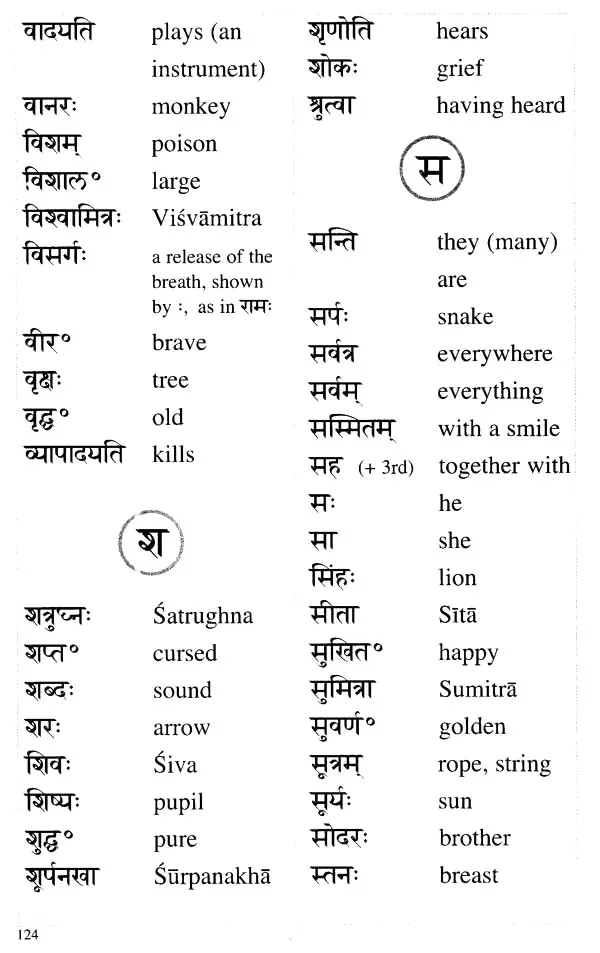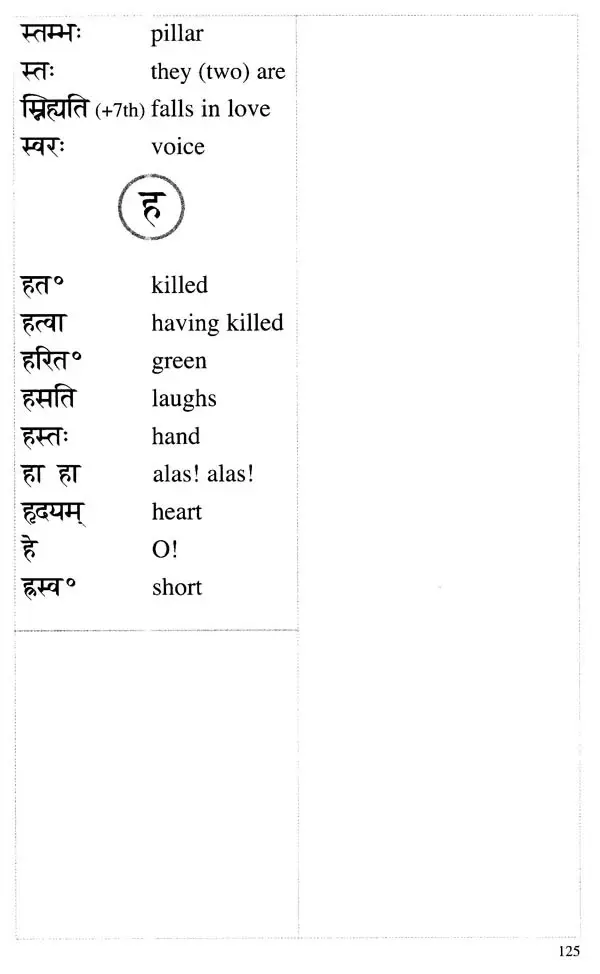
The Story of Rama- A Sanskrit Coursebook For Beginners (Part- 1)
Book Specification
| Item Code: | UAT316 |
| Author: | Warwick Jessup and Elena Jessup |
| Publisher: | MOTILAL BANARSIDASS PUBLISHERS PVT. LTD. |
| Language: | Sanskrit and English |
| Edition: | 2016 |
| ISBN: | 9788120835504 |
| Pages: | 125 (B/W Illustrations) |
| Cover: | PAPERBACK |
| Other Details | 11.00 X 8.50 inch |
| Weight | 340 gm |
Book Description
The Story of Rama books (Part I-II) together relate in 16 episodes, the story of the Ramayana. Part I introduces : the standard method of transliteration the gerund ('having done something'); and the declension of the Sanskrit word for 'that' in all three genders. Part II covers an introduction to the imperative mood; other important noun and pronoun declensions; 'having done something' used with prefixes; the past passive participle; the conjugation of the middle voice and the verb ' to be' in present, future and past tenses; and the completion of the standard of the standard method of transliteration.
It is a privilege for me to be invited to introduce this set of textbooks. They have been compiled with loving care by the teachers of the Sanskrit Department of St James School in London. Their slow birth reflects the years of teaching experience which have gone into their making.
Sanskrit is by no means an easy language: even in India it is mastered only by a small minority of the population. The grammar is complicated, even if someone who masters it will finally discover that it is more systematic and less irregular than that of English. The vocabulary is vast, reflecting the vast span of time and geographical area over which Sanskrit has been used. Learning to read and write an Indian script is also a major undertaking for a student from another culture. (Luckily for us Europeans, at least it is written left to write and top to bottom.)
On the other hand, Sanskrit is not only a beautiful language written in a beautiful script; it is the vehicle of classical Indian culture, the culture which has given the world one of its greatest literatures and greatest civilizations. Sanskrit achieved something not very different from the form it still has today more than three thousand years ago. The reason why it has survived so well, and may well outlive most of the languages which the world is now using, is not hard to understand: it is because of the aesthetic attractions and the intellectual and spiritual value of the content of so many Sanskrit texts.
Only a few students are likely to have the opportunity to go on to study Sanskrit in depth, so that they can enjoy reading Sanskrit by themselves. There will be so many rival claims on their attention. But even those who only work through these books are likely to look back on the experience with satisfaction, a feeling that they have done something truly worth while. And the few who go further will be grateful that these books have launched them on an unforgettable experience.
After a thorough perusal of these text books written by teachers of St James Schools in London for the teaching of Sanskrit, I am convinced of their utility for Indian schools. They are well-graded and supported by appropriate illustrations that make them very attractive to learners, particularly the young.
Today many Indian universities offer Sanskrit as an optional subject, even for those who are majoring in other subjects. For these students the books would be very effective in introducing them to Sanskrit which they might not have studied previously. The books could also be useful for those involved in performing arts like dance and music, or for students of Yoga and Ayurveda, subjects which have many Sanskrit references.
The first group of books entitled Sanskrit is Fun (3 volumes) introduce the learners to the Devanagari alphabet grouping the letters according to their place of articulation. Each group is given a designation, ‘Family’. The ‘Family’ comprises both the vowels and the consonants. The learners are first taught how to draw the letters. The teaching is also helped by the humorous presentation of them in the form of animal figures. The next step is to add vowels to the consonants and then to teach joint consonants. Finally words and sentences are formed.
The second group of books seek to teach Sanskrit with reference to age-old stories of Krishna (2 volumes) and Rama (2 volumes). These stories with perennial interest of their own are then pressed into service to teach vocabulary, the formation of nouns and the conjugation of verbs in all three tenses. Adjectives and prepositions are also covered.
By the time learners have completed these books it is expected they would have a good basic grasp of the Sanskrit language, its vocabulary, structure and grammar. These books are an attempt to teach Sanskrit in a simple and systematic way that may well dispel the notion that Sanskrit is a difficult language.
Language is fundamental to a human being. For this reason, it is a primary element in education. Language is one of the greatest gifts that a student is given. How a person learns to speak is all important and will be determined by example. So the aim of the teacher should be to present the student with the finest language.
Linguists agree that one of the finest languages is Sanskrit. Sir William Jones, recognised as a founder of modern linguistics, said in 1786:
"The Sanskrit language, whatever be its antiquity, is of a wonderful structure; more perfect than the Greek, more copious than the Latin, and more exquisitely refined than either; yet bearing to both of them a stronger affinity, both in the roots of verbs and the forms of grammar, than can possibly have been produced by accident."
The considerable benefits of studying the classical languages, Greek and Latin, have been known in the West for hundreds of years; indeed, in recent centuries some of the best education available in the world has been based upon them. However, Sir William Jones had discovered a classical language par excellence, more ancient than Greek or Latin, which had been preserved intact for thousands of years.
The word ‘Sanskrit’ means ‘perfected’, for its sound system and grammar are scientifically structured. It has even been put forward as being the most suitable language for use in computers (see ‘Knowledge Representation in Sanskrit and Artificial Intelligence’, The A.J. Magazine, Spring 1985).
Sanskrit also has one of the greatest literatures known to humanity. The Sanskrit epics, the Ramayana and the Mahabharata, are inspiring and fascinating. Readers of all ages love these stories and enjoy the company of great and heroic men and women.
**Contents and Sample Pages**















